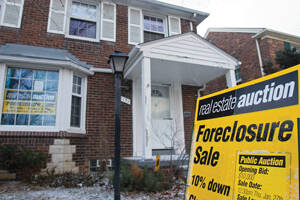Lawrence Avery (not his real name) thought he was about to fulfill a long-postponed American dream when he decided, at 54, to buy his own home. “You know what they say; don’t wait to buy real estate; buy real estate and wait,” he says, remembering his enthusiasm for a home purchase after years of renting apartments. “Everybody said [home values] will always go up.”
Not only was he buying, he was shooting the moon, moving out of his crowded Bronx neighborhood and into a comfortable house in Mount Vernon, N.Y., a working-class, predominantly African-American suburb. His timing could not have been worse. Mr. Avery bought his dream house in 2007, just as a national real estate swoon landed on New York. Within a few years his two-family house was valued at half what he would have laid out for it. That is, if he had laid out anything for it.
A recipient of what Peter Spino, a foreclosure prevention counselor for Westchester Community Housing Innovations, calls “liar loans,” Mr. Avery was asked for no documents to secure his mortgage; his bank and broker relied merely on his high credit rating and reported salary. “At that time,” Mr. Avery says, “if you had a pulse, you could get a mortgage.”
In the past, former Mayor Clinton Young remembers, Mount Vernon residents were locked out of fair mortgages by bank redlining. This time the problem was the opposite. Predatory lenders found Mount Vernon’s neighborhoods attractive sites for quick profits in refinancing schemes. Some lenders directed borrowers to subprime loans, which are more profitable to banks and brokers, even when they qualified for standard mortgages. (Countrywide Bank settled with the Justice Department over such practices, paying a $300 million fine.)
Veronica Raphael, director of Foreclosure Prevention for Westchester Residential Opportunities Inc., reports that many of the people she works with signed loans they did not understand. “They trusted the professionals they paid to advise them, including the attorneys,” Ms. Raphael says.
Additional resources for individuals facing foreclosure can be found here.
The experience seemed painless to all parties as long as property values headed up, but when they started to fall many residents found themselves doubly trapped with debt burdens and diminished home values. Even longtime Mount Vernon homeowners with substantial home equity ended up losing their homes after predatory sales pitches ignited a craze for cash-out refinancing in the community in the years leading up to the collapse.
“I saw people take out $100 thousand to $200 thousand in one refinance,” says Mr. Spino. As home values dropped, excessive refinancing left homeowners with little to no equity but much higher monthly debt-servicing burdens.
Mr. Avery’s broker assured him that when the loan’s adjusted rate kicked in, he could return for a fixed-rate 30-year loan. Securing another loan for the down payment, the broker arranged what would become a disastrous debt bundle. When the time arrived for the promised refinance, Mr. Avery’s home value had plummeted, and he could not escape his high-interest deal.
His mortgage jumped from $2,000 a month to $3,500. Mr. Avery remembered, “It was tough there for a while, robbing Peter to pay Paul.” Still, he was among the lucky ones in Mount Vernon. With Mr. Spino’s help, he arranged a loan adjustment that has allowed him to stay in his home and within his budget.
The Damage Done
Millions of other homeowners nationwide have not been so lucky. A recent report from the Bipartisan Policy Group surveys the damage. The effects of the foreclosure crisis have been dispersed ethnically and geographically (although just 10 states account for almost 70 percent of the nation’s total foreclosures). But while homeownership fell modestly for white non-Hispanics under 65, the housing bust has been especially hard on Latino and African-American communities, which have given up all the historic gains in homeownership they experienced between 1992 and 2000. Worse, the study reports that largely as a result of this fall-off in homeownership, the median wealth of African-American and Hispanic households has declined by one-half to two-thirds. How did things get so bad so fast?
The Web site RealtyTrac has become the go-to source on the state of the nation’s foreclosure market and, by extension, its real estate market. Even government agencies use the data, says Daren Blomquist, director of marketing communications. That is because in the past, foreclosure numbers were so low no one bothered to track them; everyone assumed banks were watching out for their own interests. In 2005, foreclosures represented just 0.58 percent of the national real estate market; by 2010, over 2.2 percent of all homes were in foreclosure, and almost 10 percent of all homeowners were considered “distressed”—somewhere between significantly behind in mortgage payments and losing their homes outright to lenders.
That 2.2 percent mortgage failure rate may not seem high, but, explains Mr. Blomquist, most banks had never experienced such a high volume of loan failure; few had set aside enough reserve to absorb the losses. Small banks began to fail, setting in motion ripples of default. Compounding the crisis were now-valueless mortgage securities and related insurance swaps. The resulting crisis in the U.S. finance sector wreaked havoc on the economy as credit locked up, businesses closed and consumer spending plummeted.
By 2009 and 2010, Peter Spino was seeing a new class of clients, not casualties of bad loans but victims of the ruined economy.
Stephanie Newhart (not her real name) was an independent “head hunter” and a happy condo owner in White Plains, N.Y., with a 30-year fixed-rate mortgage. Divorced with adult children, she took care of herself. Her business was booming; her savings and retirement accounts well stocked. Then 2008 rolled around and her business came to a dead stop; she could not place clients in jobs that did not exist. Maintaining the mortgage meant exhausting her savings and looting her retirement funds.
Ms. Newhart has worked on her loan modification for almost three years, but her lack of employment makes her a bad risk. The process has been emotionally and physically exhausting. She is convinced that stress drove her into the hospital last December with pneumonia; the unexpected medical costs only added to her financial troubles. “I’m just so grateful my children were already grown,” she says. “If I had children to take care of during all this, I don’t know what I would have done.”
Long-Term Troubles
Much is sacrificed in the struggle to save a home. Foreclosure counselors report stay-at-home moms leaving their kids to find work; fathers taking second, even third, jobs to stay afloat; families doubling up; retirement and savings accounts drained; stress-driven divorces.
Many economists, tracking the effect of the foreclosures, now predict a market recovery this year or by 2014; some say even later. Who knows? RealtyTrac’s Daren Blomquist says there is evidence that the overall housing market has begun to stabilize. He thinks foreclosures may have peaked in 2010. “We’re heading in the right direction,” he says. “It’s still going to be a matter of years as opposed to months before foreclosure rates return to normal in most areas.”
But the long-term impact of this foreclosure crisis will be measured over the next generation, as young people come of age in families with no savings to pay for their college and as older homeowners approach their senior years with diminished retirement accounts and home equity.
The legions of distressed or foreclosed properties still held off the market by banks threaten any long-term recovery of real estate value. But the Bipartisan Policy Center comments on a less-observed problem. In the coming decade the nation will have to absorb an increasing number of existing homes released into the market by retiring baby boomers. That overflow will continue to depress housing prices. Compounding the problem is the economic weakness of the “echo boom” or millennial generation (born between 1981 and 1995). Dislodged by economic crisis as they entered adulthood and facing tight credit restrictions, the echo boomer generation may experience deferred marriage, parenthood and “household formation.” It may not be aggressive enough in home buying to propel the economy forward.
End of the Tunnel?
Anthony Marciano, a Century 21 realtor who works in Mount Vernon, says business has picked up a little this year, but his clients now tend to be investors. He is happy for the sales and thinks the appearance of bargain-hunters is a step in the right direction for the city. “Very few [individual buyers] can do the kind of work that these houses require,” Mr. Marciano says. “Some of them have been vacated over two years.”
During a long stretch of abandonment, a great deal of damage can be done to a property by vandals, scavengers, squatters, drug dealers and their clients, he says. The longer an uninhabited home is off the market, the more damage it incurs and the harder it is to sell. Such a vicious cycle of degradation can cripple a community like Mount Vernon. “Some of these homes have been decimated,” says Mr. Marciano. “There is really nothing left.” Thieves have stolen even the copper fixtures and plumbing from some properties.
Though some may consider this to be vulture capitalism writ small, the phenomenon of real estate investors circling with an eye on quick renovation and turnover or conversion of single-family homes into rental units is a development that could be “positive for the city,” Mr. Marciano says. With investor-buyers, Mount Vernon is “getting people who can afford to be in the house,” says Mr. Marciano. “People are getting homes that have been renovated; and once you renovate one house, that starts changing the whole look of the block.”
Mr. Blomquist agrees. “Real estate investors and speculators...could really help by buying up inventory in this market.”
It is a process that the Obama administration is now encouraging on a grand scale by inviting large investors to take large blocks of property off the hands of Fannie Mae and Freddie Mac at sale prices.
Ms. Raphael argues more must be done to end the crisis. She says the federal government must try something dramatic, like a reduced loan rate for all Fannie Mae- and Freddie Mac-backed mortgages. Mr. Spino suggests that banks should fast-track procedures to speed both loan modifications and foreclosures through the system; Mr. Marciano suggests a new round of first-time homebuyers’ tax credits.
A Role for Religious Communities
Religious institutions and local community groups too can play an important role in responding to the crisis. Ms. Newhart says her tough-luck story has ended as happily as it could, because she was able to tap into community services. After she visited her temple, feeling in need of spiritual sustenance, her fortunes began to change. “If you can get quiet enough to listen, that’s what can happen,” she says.
At the synagogue she found a brochure for Westchester Jewish Community Services. Through that agency she connected with a support network of other people who were struggling as she was; she found job leads, financial counseling and other services that helped her get back on her feet. She landed a full-time job with benefits last December, and the dependable income was sufficient for Citibank to approve her loan modification. Now she can remain in her home and start rebuilding her life; her retirement is not far off. “I have to start from scratch,” Ms. Newhart says; “What else can I do?”
Mount Vernon, says former Mayor Young, has learned some hard lessons in financial literacy. “Unfortunately the stakes were extremely high for the lessons that had to be learned,” he says. In addition to the abandoned homes, he says, the town’s civic spirit was deeply damaged by the departure of residents, many born and raised in Mount Vernon, who lost their homes.
“We are in the process of recovery,” Mr. Young says. The people who remain, he says, “are still committed to the success of their neighborhoods and the success of this city.”
Additional resources for individuals facing foreclosure can be found here.









I think it is an unfair assumption that the investors are the same individuals who brought on the real estate collapse. The situation is that most people did not lose their homes, but large numbers of people are wary of committing to a home purchase now. People these days want to rent, not buy, so whether or not the investors are greedy or guilty, they are the best hope.
When first I saw the graph, I thought something was wrong. However, until I worked out NV, I didn't know exactly what. I should have snapped right to it, even though it has been 4-5 decades since I last had math classes.
Fundamental lack of knowledge in math and science by all citizens causes choices that go against reason.
But of loans they originated and held, in GA especially, which has one of, if not the highest, failure rate by number of banks in the nation, the problem is contruction and development loans which are bringing them down and continue to do so.
Not only are there completed and lived-in houses unsold, there are completed new houses unsold still owned by the developer or now a bank. There are uncompleted new houses unsold still owned by the developer or now a bank. There are developed and partially developed sites for new houses unsold still owned by the developer or now a bank.
And there is each of the same for commercial property.
The false optimism which caused the houses to be sold causes the business space to be vacant. Construction jobs have dried up except in the rehab business, because of the huge oversupply of available properties.
And yes investors and speculators are helping by providing jobs to get the residential and commercial properties "user-ready".
All people who did not assume a large risk when they bought their house will not have a problem. Those who did assume risk, are finding that risk has a chance of becoming real. That is the meaning of risk.
When the memory of evil receeds, either of war or financial crisis or ..., the chance of its return increases. Who said "Those who do not study and remember history are likely to relive it."?